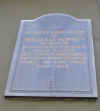
William Lovett The Chartist
William was sent too one of the Dame Schools where he learned to read and write and in due course he was apprenticed to his uncle's trade of rope making. As the Napoleonic War came to an end the need for rope was declining. The use of chains and cables was growing as their production became cheaper. William found himself in the position of having to take his employer to law in order to get his wages. He won his case and persuaded his employer to release him from the remainder of his indenture in order that he could accept an offer from his great-uncle of a job on his fishing boat. His career as a Newlyn fisherman came to a speedy end when he realized that he suffered from seasickness when the weather was rough. Seasickness was about to change his whole life and the political face of Britain.
Luckily William had a natural aptitude as a woodworker and had taught himself the craft of cabinet making in his spare time. He found a new home for his grandmother and he and his mother left Newlyn and made their way to London in 1821. At first he could only find work in non-society carpenters shops as he was not a time served craftsman. However, he so impressed that he was allowed to join the closely organized Cabinetmakers Society and actually became its president, as well as being the man who wrote the charter that became the basis of the 'Chartist' movement. He could be described as one of the founders of what eventually became the Trade Union movement.
Note1. The cottages were later demolished to make way for the building of the Primitive Methodist Chapel.
Source Chartist Portraits by G.D.H.Cole Published by Macmillan 1941.
-----------------------------------------------------------------------------------------------------------
![]()